Introducing this year's list
Open source projects and practices have always enjoyed a complicated relationship to change.
To change is to productively evolve. Working transparently and collaboratively excellerates the speed at which we can build wonderful things together. It also allows us to fail more quickly in the process. And the faster we fail together, the faster we eventually hit on workable solutions to the problems that confront us—and the more adaptable, the more comfrotable with change, we become.
At the same time, of course, to change is to modify. Open source technologies protect us from undue alterations, those too-sudden shifts in the technical and legal landscapes that govern what we can do with our tools. The more opaque our technologies, the more we remain at the mercy of those with exclusive power to reshape those landscapes against our will—to impose unwanted and unwarrented changes to the objects and platforms that are integral to our lives.
Call it open source's Change Paradox: the ability to both catalyze and mitigate, to advance and resist.
This year's Opensource.com Annual Reading List embodies the tension between flux and stability that sits in the heart of the open source way. The books here (each hand-picked and reviewed by a member of the Opensource.com community) grapple with the nuances of change. They focus our attention on changes we may not have noticed. They equip us to respond to changes we have. They compel us to make the changes that will better our lives. And they bolster our skepticism of the changes others have deemed inevitable.
In short, these books make coping with change—embracing the changes we might welcome, defying the ones we don't, and more astutely telling the difference—a bit easier. What philosopher Heraclitus once said rings as true today as it did in ancient Greece: "Everything changes and nothing remains still." The 2014 Opensource.com Annual Reading List insists on the centrality of open source tools, values, and ideas in an ever-changing world.
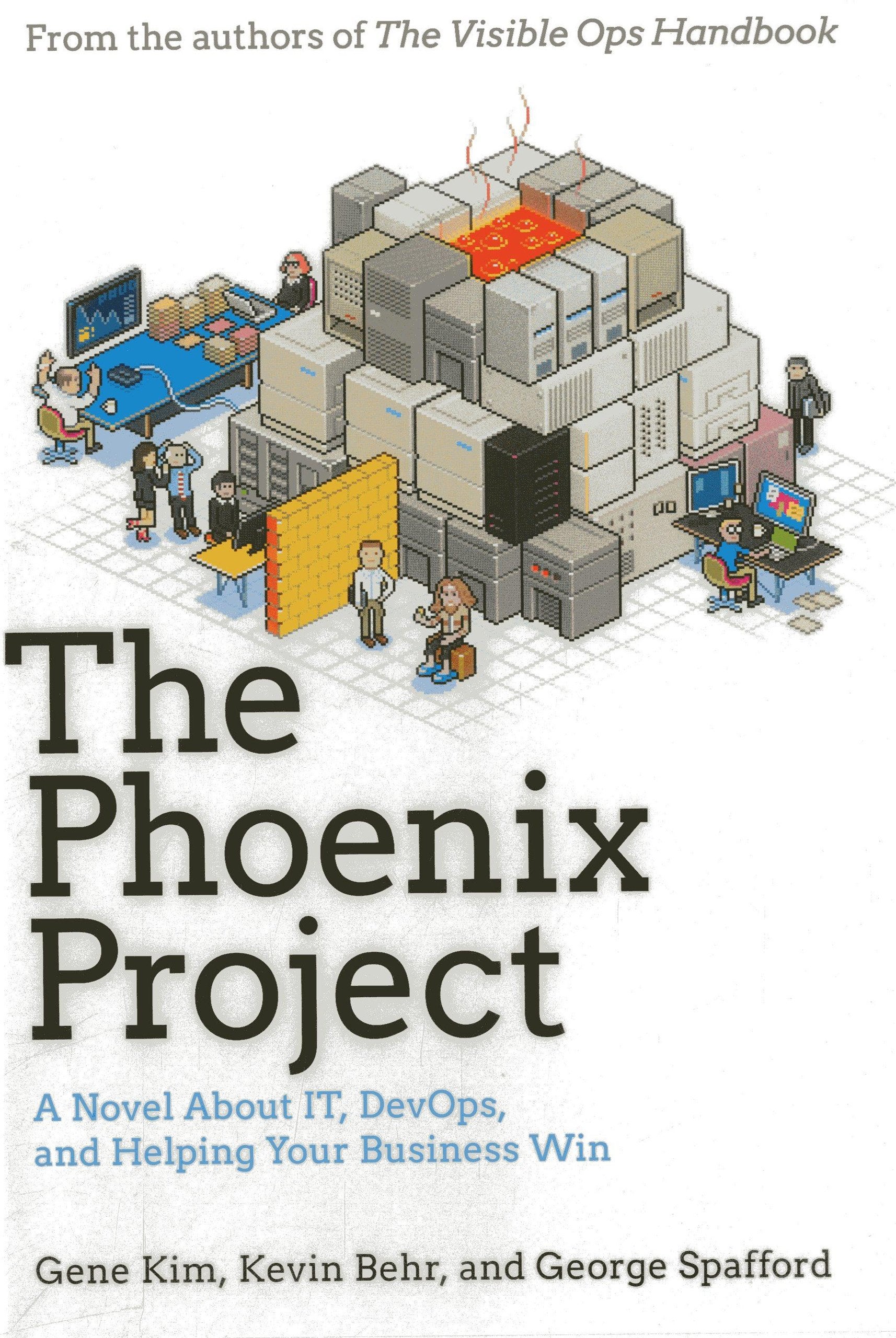 The Phoenix Project
The Phoenix Project
by Gene Kim, Kevin Behr, and George Spafford (recommendation by Dave Neary)
One day you come into work at your struggling car parts manufacturing company and find that your VP of IT Operations has been fired. You're now in the hot seat. You become responsible for all current IT projects, including the deployment and maintenance of the long-overdue, "make or break" e-commerce portal that everyone is relying on to save the company. What do you do?
In this very entertaining book, Gene Kim does what you might think is impossible: he writes a page-turner about running IT operations. Bill Palmer is on a Hero's Journey, going from one crisis to the next on a voyage of discovery in the land of DevOps. For people working in open source communities, there are lots of good lessons to learn here—avoiding single points of failure, the importance of situational awareness and good communication, and understanding the big picture of what people want to achieve when they work with your software.
Be careful, though; you'll never be able to look at someone named "Brent" in the same way again.
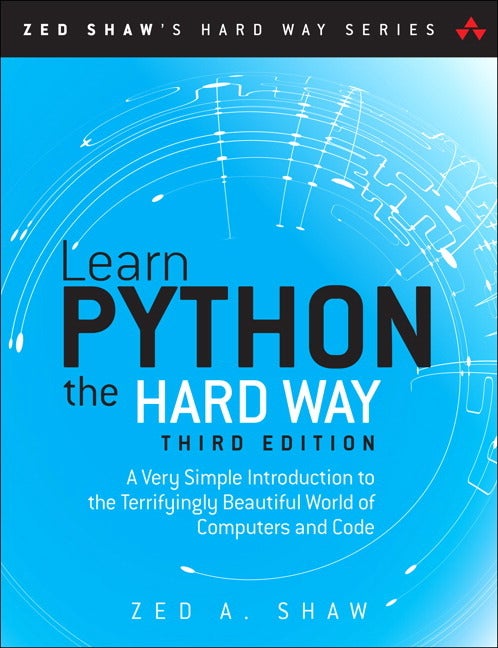 Learn Python the Hard Way
Learn Python the Hard Way
by Zed A. Shaw (recommendation by Joshua Holm)
Python is a great language choice for someone beginning to learn computer programming. Learning Python means you can hack on your Raspberry Pi, contribute to OpenStack, or do just about anything else in between. Learn Python the Hard Way by Zed A. Shaw is an excellent learning resource for the beginning Python programmer. Don't be turned off by the "hard way" bit; the book's exercises are well thought out and pedagogically sound. In fact, doing things the "hard way" will actually make you a better programmer in the end.
Through a series of 52 exercises (53 if you count lesson 0, which is setup), the learner develops an understanding of how to program in Python while learning the underlying concepts that are common in all computer programming: variables, functions, logic, and loops. Shaw's lessons are also designed to develop important programming skills like problem solving and attention to detail. Many of the exercises' study drills involve figuring out why things work—or why they don't. Learners are expected to think things through (while occasionally getting frustrated) and feel a sense of pride and accomplishment when they've finally figured something out. In addition, the book contains an appendix with 15 lessons that are a "crash course" in using the command line (BASH for Unix-like OSes and PowerShell for Windows).
You can read the web version of the book for free on the Learn Python the Hard Way website. You can also purchase digital access to companion videos and downloadable versions of the book in epub, mobi, and PDF formats. Addison-Wesley Professional publishes a print edition of the book for those who want a physical copy.
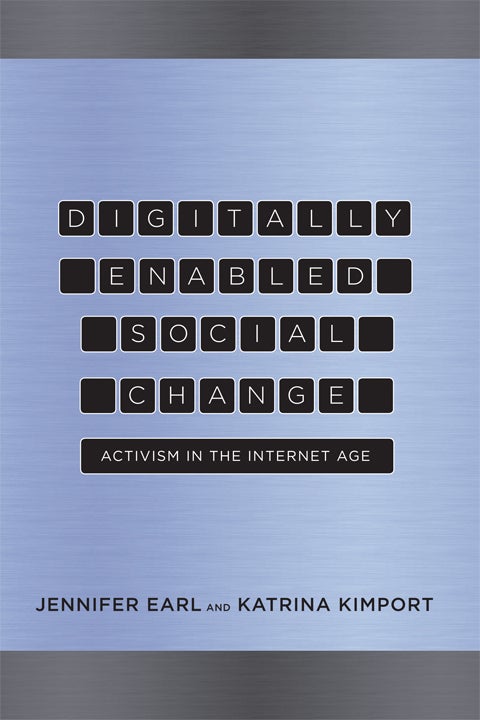 Digitally Enabled Social Change
Digitally Enabled Social Change
by Jennifer Earl and Katrina Kimport (recommendation by Bryan Behrenshausen)
You've already heard both sides in the tired debate over the role web technologies play in contemporary social and political movements. "The web alters everything!" some say. "Organizing and mobilizing for social change will never be the same again! We need to rethink everything we know about studying activism today!" And others retort: "Politics have changed very little in recent decades! New technologies simply extend and amplify older tendencies! We needn't modify our research programs one bit!"
In Digitaly Enabled Social Change, Jennifer Earl and Katrina Kimport attempt to locate some much-needed middle ground between these two academic positions on the nature of activism in the Internet Age. The authors call the former camp "theory 2.0 scholars," prone as those researchers are to insisting that every theory of social change must be overhauled in the wake of phenomena like social media. Their opponents, however, are what Earl and Kimport call "supersize scholars": folks who argue that new media do little to reshape the foundational principles of effective political organization—even if those media do affect the scale, scope, and speed of that organization.
Yet each of these positions, Earl and Kimport conclude after years of data collection and analysis, limits itself to the study of very particular objects, then strategically generalizes the effects of those objects. Theory 2.0 scholars, for example, tend to focus on what Earl and Kimport call "e-movements," those social movements "native" to digital spaces and practices (like flash mobs or strategic voting)—hence their insistence that all citizen political activity is changing radically. Supersize scholars, on the other hand, tend to examine the ways political organizations with robust offline presences transition to a web-enabled world—hence their claims that new technologies simply recalibrate more traditional activities.
Earl and Kimport skirt both these positions when they offer a more nuanced analysis—one neither rebooted nor supersized—of how new technologies are really affecting activism today.
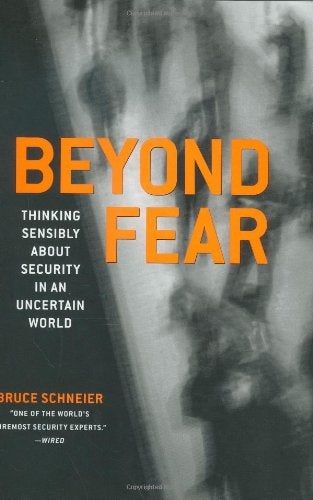 Beyond Fear
Beyond Fear
by Bruce Schneier (recommendation by Kevin O'Brien)
There is an old joke about what constitutes a secure computer. The punchline is that it has to be locked in a vault, with no network connection, and no power connection, and even then you need to worry about who can access the vault. It is a joke, of course, because no one would ever do this. We use computers and the Internet because of the benefits they give us, and having a computer in a vault is just a waste of money. We accept a certain degree of risk because that is the only way to get the benefits we want.
In 2003, Bruce Schneier published Beyond Fear, in which he demonstrates that hysteria is not a good approach to security. Schneier argues that you need to ask yourself some questions to see what the cost vs. benefit calculation for implementing a security measure looks like for you.
In this book, Schneier develops a five-question model for evaluating security:
- What assets are you trying to protect?
- What are the risks against these assets?
- How well does the security solution mitigate the risks?
- What other risks does the security solution cause?
- What trade-offs does the security solution require?
Going through this process once is not the end, Schneier says; you need to re-evaluate your choices as systems evolve and as technologies change. His five-question model works as well now as it did when it was written in 2003.
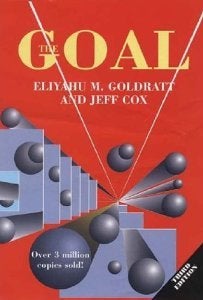 The Goal
The Goal
by Eliyahu M. Goldratt and Jeff Cox (recommendation by Jeff Mackanic)
The Goal was first published in 1984. Yes, 1984.
It's an easy to read, engaging novel about a fictitious manufacturing plant and a young plant manager who is facing a tough situation: He needs to drastically improve plant performance within several months or else the plant will be shut down.
Several big questions emerge from this book:
- What is your goal? (From The Lean Startup, which I reviewed last year: the goal is not a new feature; it probably revolves around sales and the customers.)
- What are the correct measures? (Frequently we measure the wrong items.)
- How can you increase throughput? (Identify the constraints that are slowing your production process.)
In The Goal's fictitious manufacturing plant, the manager and his team identify several bottlenecks in their production line. Then they implement creative tactics to eliminate those bottlenecks (changing lunch schedules, outsourcing certain work, changing the workflow process). Making the connection between The Goal and DevOps was easy. IT does have much in common with an assembly line, as implementing a new software application goes through a manufacturing-type process to get it live (business goals, requirements, Dev, test, QA, production, updates, etc.).
You can apply lessons from The Goal right now. Take a few minutes and think about your current job. What is the actual goal? To make more money? Attract more users? Teach more students? Then think of your work process as you would a manufacturing process: What are the constraints in your production process? What are creative ways to minimize those constraints to increase throughput?
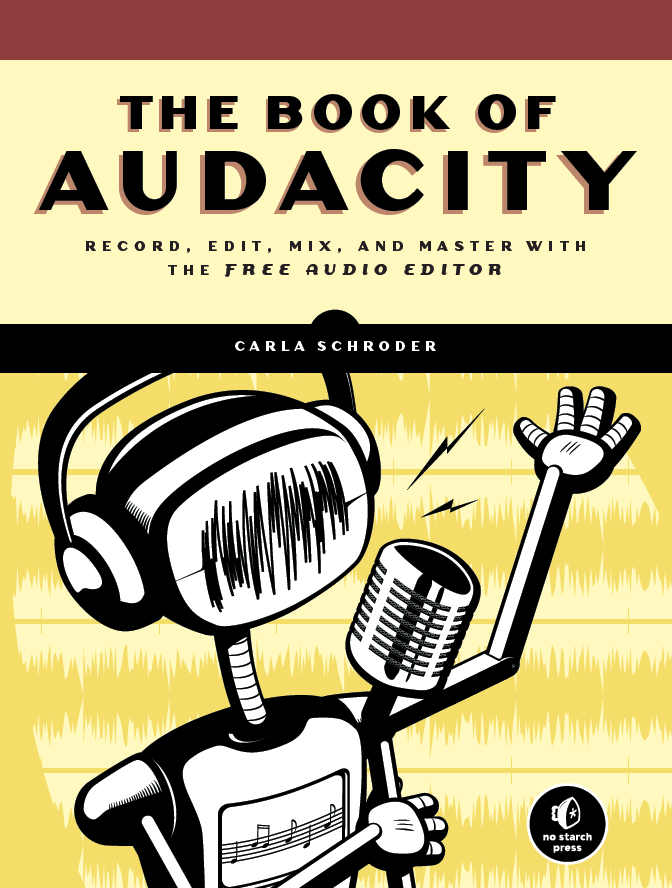 The Book of Audacity
The Book of Audacity
by Carla Schroder (recommendation by Phil Shapiro)
Audacity is a popular free sound recording and editing program for Linux, OS X, and Windows. I've been using it since it first came out, but I always fumbled here or there with some of its features. Fumble no more. This extensive and fun to read guidebook will take your fumbles away. Written by tech veteran Carla Schroder, this book gives you the kind of advice and information you'd get from a friend. A very smart friend.
Explaining audio engineering concepts is no easy matter, but this book rises to the task. What I appreciated most were the tips and tricks from someone who has used the program a lot. Carla Schroder covers Audacity on both Linux and Windows. Since the program is virtually identical on the Mac, Mac users should not feel left out.
I loved seeing a photo of the sound recording studio the author has set up for herself. A full chapter of the book explains how you can set up your own sound recording studio. This book gives recommendations on which microphones to buy and how to set up your mics for best sound recordings.
For you musicians out there: the author explains all the different ways you can now sell your music online and the most recommended audio formats in which to offer your music. I was very happy to see the FLAC format—a lossless audio format—praised several times in this book.
The Book of Audacity is a recommended purchase for public libraries, school libraries, makerspaces, and anywhere else the do-it-yourself spirit flourishes. Public libraries that have their own makerspaces would be wise to purchase multiple copies of this book.
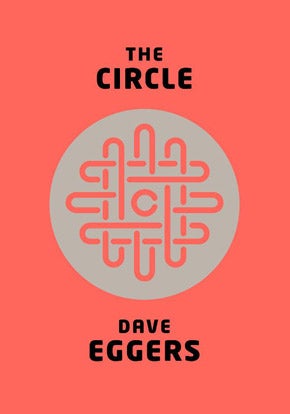 The Circle
The Circle
by David Eggers (recommendation by Rob Tiller)
It's the season for beach reading, but it's hard to find a worthwhile open source-related read that goes well with sand, sunscreen, and beer. For this hard-to-fit niche, I nominate The Circle, by Dave Eggers. The novel is kind of trashy, but kind of thought-provoking.
The story concerns Mae, a young woman who lands a job at the Circle, a fabulously successful technology company modeled on an outfit in Silicon Valley that provides search engine and other capabilities. The campus is gorgeous, the perks are fun, the people are extraordinary, and the technology is cutting edge. As a newby, Mae works in Customer Experience answering client complaints but soon distinguishes herself as an eager Circler and rises in the ranks.
The Circle's latest business innovation has to do with radical openness, transparency, and sharing. Mae joins the pilot project, which requires that she wear a small camera that broadcasts to the world her every word and action. As she articulates the values involved: "secrets are lies," "sharing is caring," and "privacy is theft." Mae ultimately wins millions of followers. Her success in radical transparency causes various problems in her relationships, and at least one fatality.
What does this have to do with open source? It's sort of a travesty of open source, but one that makes us think about whether and when there should be boundaries on openness. The prose is not very good, but not so bad as to make you, or at least me, stop reading. It is, in the end, a beachy page-turner and will hold you in its grip until the shocking denouement.
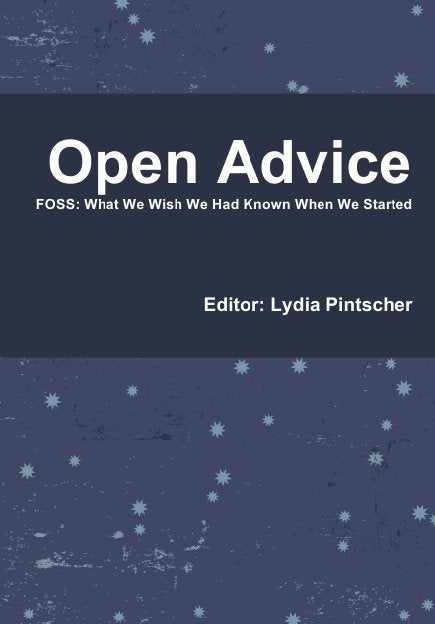 Open Advice
Open Advice
edited by Lydia Pintscher (recommendation by Scott Nesbitt)
So you want to contribute to an open source project but don't know how to get started. Believe me, that's not uncommon.
If you're looking for a guide to getting started with an open source project, then Open Advice is worth a read. Edited by Lydia Pintscher, Open Advice tries to answer the question What would you have liked to have known when you started contributing?
To do that, Pintscher has gathered essays from a 42 prominent contributors to a variety of open source projects. Their essays cover a range of contributions that you can make to a project but also the pitfalls that you might encounter.
Open Advice is also about gaining new perspectives on open source projects. Some of the essays—like "On Being a Lawyer in FOSS" and "Free and Open Source-Based Business Models"—will open your eyes to aspects of free and open source software that you perhaps wouldn’t normally have considered.
Keeping with the free and open theme, you can download PDF, ePub, and mobi versions of the book. You can even grab the LaTeX source files off GitHub. Or, you can buy a printed version of the book.
Open Advice is an interesting and enlightening read. Not every essay will engage you, but that’s to be expected. The ones that do, however, will get you thinking about open source projects in ways you might not have in the past. And Open Advice just might encourage you to get back on the horse and ramp up your contributions. It did with me.
If you’re interested in contributing to an open source project, grab a copy of Open Advice. Read the sections covering areas that interest you. Learn the lessons in the book, then find a project. You might bounce around a few before you find the project that best fits you. But armed with what you learned from Open Advice, you’ll be able to find your niche.
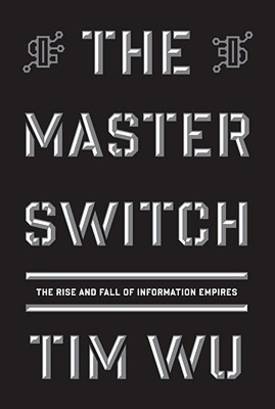 The Master Switch
The Master Switch
by Tim Wu (recommendation by Tamara Manik-Perlman)
Technologists, often enamored of the new, can be amnesic about the ways in which our disruptive innovations are subject to the same monopolistic forces and regulatory failures that have plagued previous technologies. While we pour our energies into the development of open source software, it's easy to forget that the success of our efforts is largely dependent on equitable access both to the physical infrastructure of the Internet as well as to the multifarious sources of information we can access through it. With the FCC inviting public comment on its proposed net neutrality rules until September 10, this is the perfect time to catch up on the history of government regulation of communications technologies.
In The Master Switch, Tim Wu transforms what could be a very dry topic into an engaging narrative about the evolution of telephony, radio, and film. Wu, a Columbia Law professor credited with popularizing the phrase "network neutrality" in 2003, identifies a pattern in the development of each that he terms The Cycle: "History shows a typical progression of information technologies: from somebody's hobby to somebody's industry; from jury-rigged contraption to slick production marvel; from a freely accessible channel to one strictly controlled by a single corporation or cartel—from open to closed system." Media monopolies are distinctive in their ability to limit de facto free expression even as it is preserved in law.
The book's culminating argument is of course that the Internet is not exceptional, and that its trajectory mirrors that of other "information empires." What is perhaps unique is the extent to which so many other cultural and commercial institutions rely on it to function. The Master Switch reminds us just how precarious the current state of freedom may be.
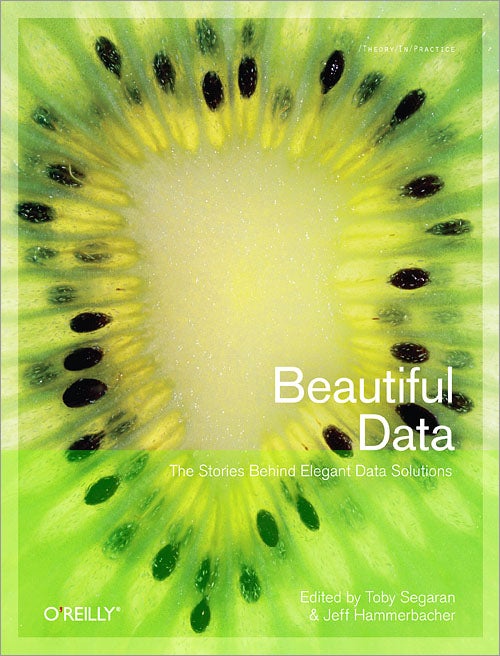 Beautiful Data
Beautiful Data
edited by Toby Segaran and Jeff Hammerbacher (recommendation by Jason Baker)
Data make the world go round. And whether you're technically inclined or not, we have become such a data-driven society that it's increasingly important to understand how data are being used. But despite data's importance, our understanding of it is one of the more neglected aspects of society's digital literacy. For many, data just sound boring. The editors of Beautiful Data take a fresh look at how data can be exciting, intriguing, and, yes, beautiful.
Rather than presenting a single narrative, the editors collected 20 individual essays exhibiting different ways that data are collected, processed, interpreted, and visualized. Think of it as a collection of short stories telling the story of how raw data become information for consumption.
Stories range widely; they convey everything from the difficulties of handling data processing on a Mars lander to the story of life's original data store (DNA), how data are used in urban environments for applications from crime visualization to mapping the housing crisis, and even how data are used in the arts (with the example of Radiohead's classic "House of Cards" music video).
You'll find numerous code samples to illustrate various ideas in the book; however, this is not a programming resource. Code snippets are here to explain concepts where words alone don't quite suffice, and they provide a little more detail to those who are interested. But don't worry. You don't need to be a coder to keep up with what's going on.
And if you purchase a copy of the book for yourself, you can feel good about the money you've spent. The editors donate all royalties they make from the book to Creative Commons and the Sunlight Foundation, supporting a future in which data is freer and more easily available.
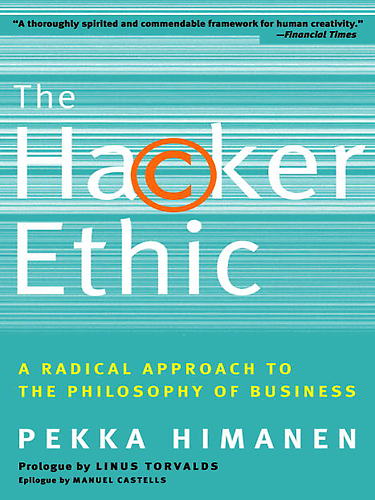 The Hacker Ethic
The Hacker Ethic
by Pekka Himanen (recommendation by Gokul Kannan)
This is an outstanding discussion of work, play, and living. While there are many books that talk about what open source is (and how to apply that philosophy in other aspects of life), this book is something different. It speaks more about the open source way of working. Throughout the book, Himanen references the development of distributed projects, notably the Linux kernel. This is where it all started—Linux—and this is where the open source development model is still an ongoing success. This is where we need to look—and learn—the open source way of working. How is it all made possible? What are the factors behind this success? How do things work in a community as big as this?
This book dispells several myths. Getting things done doesn't demand a slavish devotion, nor a discipline. I'd like to point out Linus' Law (a.k.a "What Makes Hackers Tick?"). Every motivation that makes a person do something can be classified under "survival," "social life," or "entertainment." As a result, progress is defined as reaching a higher category—that is, not doing a thing merely for survival, but for social reasons, and, even better, just for fun.
If you're a hacker, I would suggest you give a copy of this book to all your friends and family.
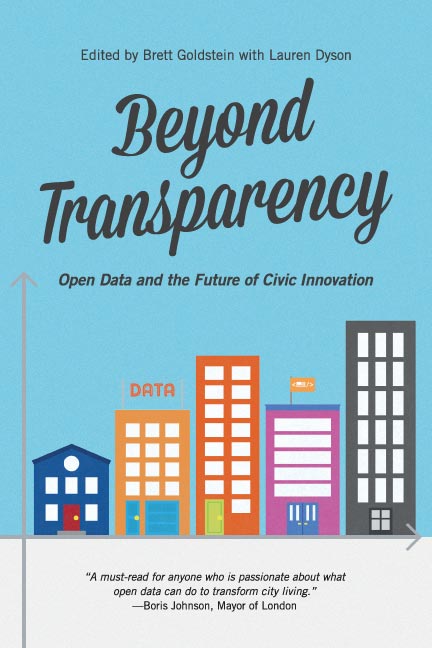 Beyond Transparency
Beyond Transparency
edited by Brett Goldstein and Lauren Dyson (recommendation by Jason Hibbets)
At the heart of the open government and open data movements are the people on the front lines. Beyond Transparency is a collection of stories, lessons, and outlooks for advancing openness in government from these trailblazers and risk takers—all curated by Code for America.
Organized into five parts, the book shows you how to open data from the government, build on those data, understand them, and make decisions with them. Finally, the book takes a look at the future of open data.
The editors describe the book as "a cross-disciplinary survey of the open data landscape, in which practitioners share their own stories of what they've accomplished with open civic data." And that's exactly what you will get out of this book. You'll read practical examples, like that of Jonathon Feldman, CIO of Asheville, NC, who describes the city's open data journey. You'll also read some new thinking from Mark Headd, former Chief Data Officer for the City & County of Philadelphia, on ways governments should be delivering services.
If you want to understand open data and how your local government can start implementing those data, enhance them, or take them to the next level, Beyond Transparency is a good place to start. My favorite part? This book is based on real-world examples from experts in the open data and open government space, and it shows how open data can be key to strategies for economic development.

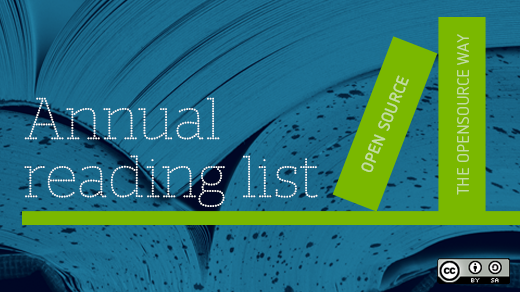

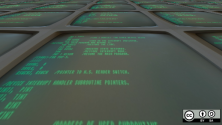

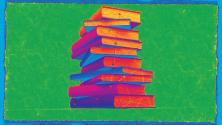

11 Comments